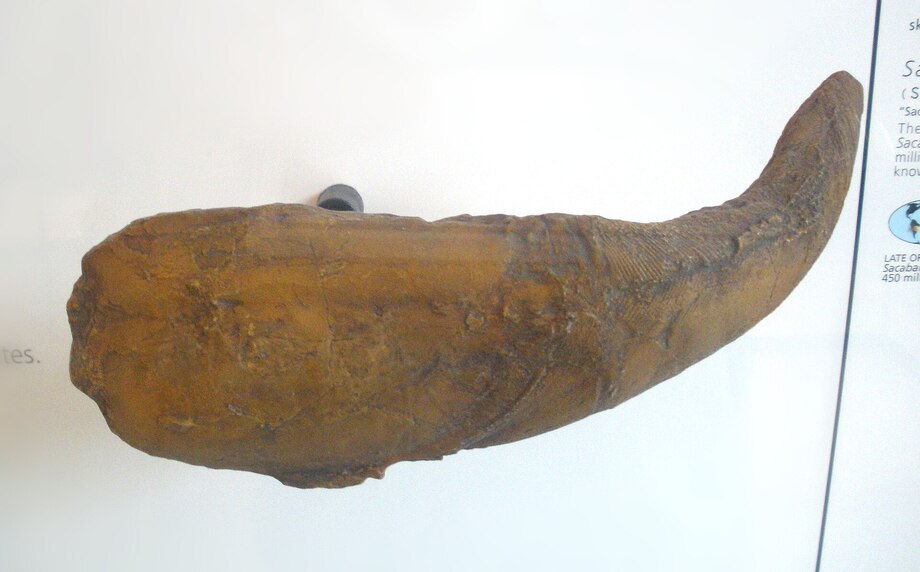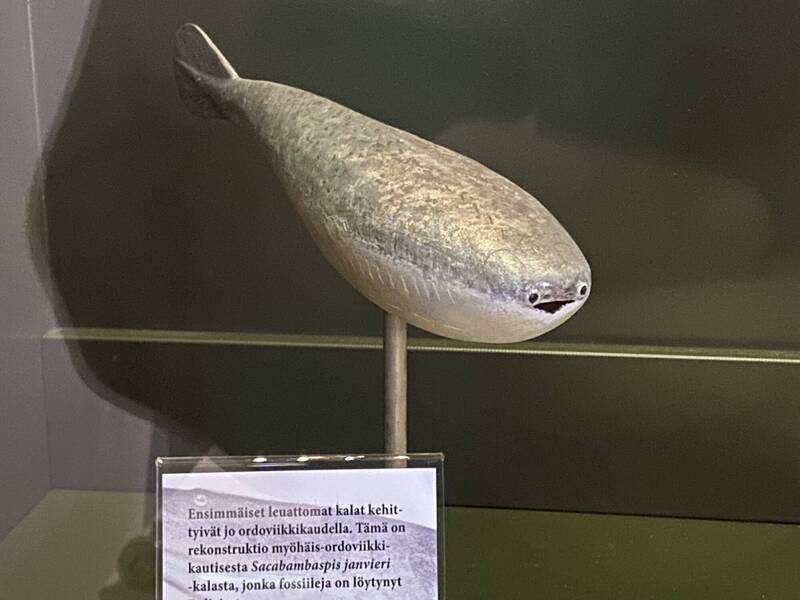Sacabambaspis (scientific name: Sacabambaspis, meaning "Armor of Sacabamba") is a jawless fish that lived in the Ordovician period. It inhabits the shallow sea on the edge of Gondwana. A close relative of the Aranda softshell turtle, a famous ancient fish with numerous fossils. At least 30 Sakaban soft-shell turtle fossils have been discovered, all from a very small area. This concentration of death in one place is believed to be caused by a large storm causing freshwater to flow into its habitat. The large number of lingual clams that died during the same period is also believed to be related to this event.

Some specimens that cannot be completely identified have been found in many countries corresponding to the margins of Gondwana: in 1997, fossils that may belong to this genus were found in some strata in central Australia. Several scales with similar patterns to those found in Bolivia have also been found in central Australia. Fossils of this genus have also been reported in Argentina. In 2009, researchers also described specimens from the Amdeh Formation in Oman. The discovery in Oman confirms that these fish are distributed in the surrounding areas of Gondwana and are not limited to the confirmed areas of South America and southern Australia.

On August 30, 2022, Kat Turk, a doctoral student in paleontology, posted a restored model of the Sakaban soft-shelled turtle photographed at the Finnish Museum of Natural History on her personal Twitter. Its cute expression sparked heated discussions on social media and became an Internet fan. because.
Sacabambaspis is an extinct genus of jawless fish, specifically an early vertebrate from the Silurian period, around 425 million years ago. It is part of a group of armored fishes known as ostracoderms, which are considered some of the earliest vertebrates to appear in the fossil record.
Classification: Sacabambaspis belongs to the sub-group Pteraspidomorphi, a group of early jawless fish that were characterized by their bony armor and lack of jaws. This group also includes other extinct fish such as Pteraspis and Cephalaspis.
Anatomy:
Body Armor: Like many other ostracoderms, Sacabambaspis had a heavy bony armor, which helped protect it from predators. The armor was made up of large, bony plates that covered the head and body. This armor is one of the defining characteristics of ostracoderms.
Head Shield: Its head shield (or cephalic armor) was large and somewhat flattened. This feature was typical among early jawless fish, offering defense against external threats.
Lack of Jaws: Sacabambaspis, like other ostracoderms, lacked jaws, which means it probably fed by filtering small particles from the water or scavenging for organic matter. This is in contrast to more modern jawed fish, which actively capture and chew food.
Habitat: Fossils of Sacabambaspis have been found in what is now South America, specifically in the region of Bolivia. The deposits indicate that these fish lived in shallow marine or freshwater environments, where they would have likely inhabited areas with abundant plankton or organic material to feed on.
Fossil Discovery: Sacabambaspis fossils were first discovered in the early 20th century, in the Sacaba Formation of Bolivia, which is how it got its name. The fossils are relatively well-preserved, offering paleontologists insights into early vertebrate evolution.
Feeding Habits: As a jawless fish, Sacabambaspis likely employed a feeding strategy similar to other early vertebrates, such as filtering plankton from the water. It may have had structures similar to modern filter-feeding mechanisms, such as gill arches adapted for trapping food particles.
Evolutionary Significance: Sacabambaspis, along with other ostracoderms, represents a crucial point in the evolutionary history of vertebrates. It provides valuable information about the development of early vertebrate features like armored plating, the evolution of the notochord (a precursor to the vertebral column), and the eventual rise of jawed fish (gnathostomes).
Extinction and Legacy: Ostracoderms, including Sacabambaspis, became extinct by the end of the Devonian period. However, their legacy is important because they represent some of the earliest vertebrates to possess a notochord, an early form of backbone. This evolutionary step is vital to understanding the emergence of vertebrates that eventually gave rise to modern fish, amphibians, reptiles, birds, and mammals.
The genus Sacabambaspis is often studied for what it reveals about early vertebrate development. Fossils of this genus contribute to understanding the evolution of early vertebrate anatomy, particularly the development of bony armor, the notochord, and the transition from jawless to jawed vertebrates. This makes Sacabambaspis an important part of the evolutionary tree, showcasing the diversity of early vertebrates during the Silurian period.
Sacabambaspis is a prehistoric, armored jawless fish from the Silurian period that provides important insights into the evolution of early vertebrates. Its armored body, lack of jaws, and habitat in ancient aquatic environments highlight key aspects of vertebrate evolution, particularly the early development of protective features and feeding mechanisms before the appearance of jaws in more advanced vertebrates.
animal tags: Sacabambaspis
We created this article in conjunction with AI technology, then made sure it was fact-checked and edited by a Animals Top editor.